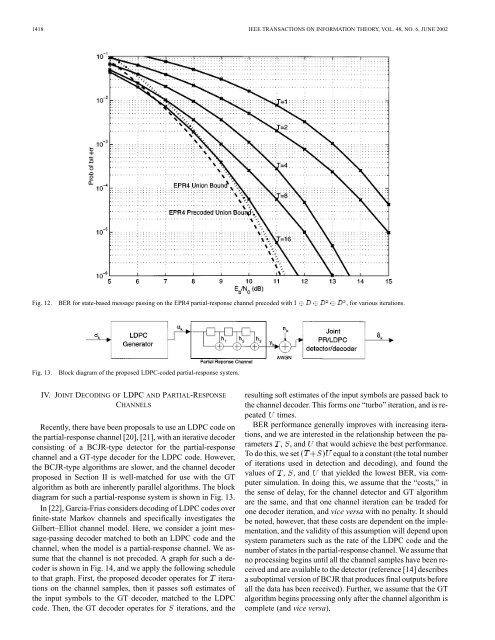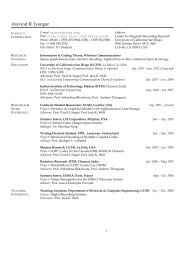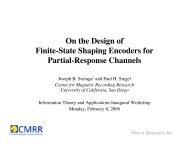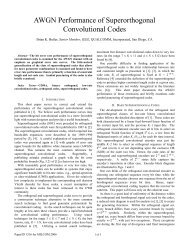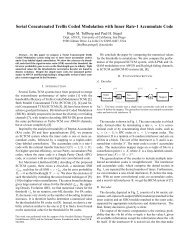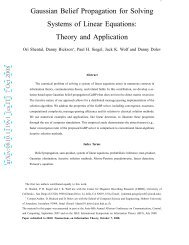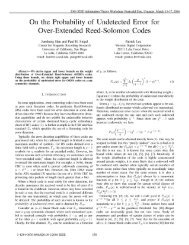Joint message-passing decoding of LDPC codes and ... - CiteSeerX
Joint message-passing decoding of LDPC codes and ... - CiteSeerX
Joint message-passing decoding of LDPC codes and ... - CiteSeerX
You also want an ePaper? Increase the reach of your titles
YUMPU automatically turns print PDFs into web optimized ePapers that Google loves.
1418 IEEE TRANSACTIONS ON INFORMATION THEORY, VOL. 48, NO. 6, JUNE 2002<br />
Fig. 12.<br />
BER for state-based <strong>message</strong> <strong>passing</strong> on the EPR4 partial-response channel precoded with 1 8 D 8 D 8 D , for various iterations.<br />
Fig. 13.<br />
Block diagram <strong>of</strong> the proposed <strong>LDPC</strong>-coded partial-response system.<br />
IV. JOINT DECODING OF <strong>LDPC</strong> AND PARTIAL-RESPONSE<br />
CHANNELS<br />
Recently, there have been proposals to use an <strong>LDPC</strong> code on<br />
the partial-response channel [20], [21], with an iterative decoder<br />
consisting <strong>of</strong> a BCJR-type detector for the partial-response<br />
channel <strong>and</strong> a GT-type decoder for the <strong>LDPC</strong> code. However,<br />
the BCJR-type algorithms are slower, <strong>and</strong> the channel decoder<br />
proposed in Section II is well-matched for use with the GT<br />
algorithm as both are inherently parallel algorithms. The block<br />
diagram for such a partial-response system is shown in Fig. 13.<br />
In [22], Garcia-Frias considers <strong>decoding</strong> <strong>of</strong> <strong>LDPC</strong> <strong>codes</strong> over<br />
finite-state Markov channels <strong>and</strong> specifically investigates the<br />
Gilbert–Elliot channel model. Here, we consider a joint <strong>message</strong>-<strong>passing</strong><br />
decoder matched to both an <strong>LDPC</strong> code <strong>and</strong> the<br />
channel, when the model is a partial-response channel. We assume<br />
that the channel is not precoded. A graph for such a decoder<br />
is shown in Fig. 14, <strong>and</strong> we apply the following schedule<br />
to that graph. First, the proposed decoder operates for iterations<br />
on the channel samples, then it passes s<strong>of</strong>t estimates <strong>of</strong><br />
the input symbols to the GT decoder, matched to the <strong>LDPC</strong><br />
code. Then, the GT decoder operates for iterations, <strong>and</strong> the<br />
resulting s<strong>of</strong>t estimates <strong>of</strong> the input symbols are passed back to<br />
the channel decoder. This forms one “turbo” iteration, <strong>and</strong> is repeated<br />
times.<br />
BER performance generally improves with increasing iterations,<br />
<strong>and</strong> we are interested in the relationship between the parameters<br />
, , <strong>and</strong> that would achieve the best performance.<br />
To do this, we set equal to a constant (the total number<br />
<strong>of</strong> iterations used in detection <strong>and</strong> <strong>decoding</strong>), <strong>and</strong> found the<br />
values <strong>of</strong> , , <strong>and</strong> that yielded the lowest BER, via computer<br />
simulation. In doing this, we assume that the “costs,” in<br />
the sense <strong>of</strong> delay, for the channel detector <strong>and</strong> GT algorithm<br />
are the same, <strong>and</strong> that one channel iteration can be traded for<br />
one decoder iteration, <strong>and</strong> vice versa with no penalty. It should<br />
be noted, however, that these costs are dependent on the implementation,<br />
<strong>and</strong> the validity <strong>of</strong> this assumption will depend upon<br />
system parameters such as the rate <strong>of</strong> the <strong>LDPC</strong> code <strong>and</strong> the<br />
number <strong>of</strong> states in the partial-response channel. We assume that<br />
no processing begins until all the channel samples have been received<br />
<strong>and</strong> are available to the detector (reference [14] describes<br />
a suboptimal version <strong>of</strong> BCJR that produces final outputs before<br />
all the data has been received). Further, we assume that the GT<br />
algorithm begins processing only after the channel algorithm is<br />
complete (<strong>and</strong> vice versa).


